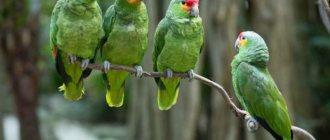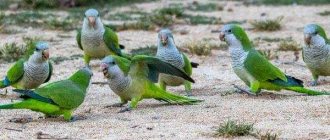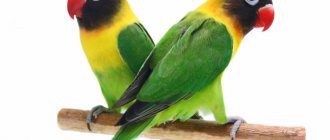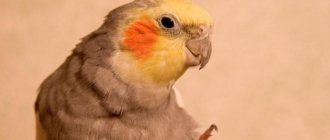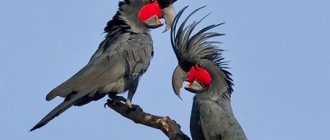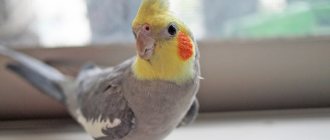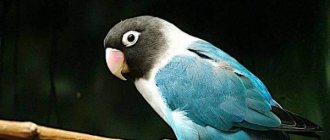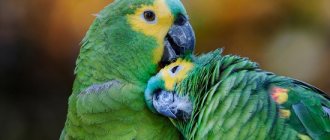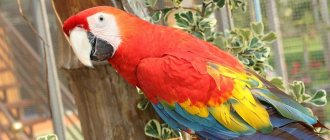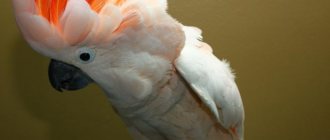There are no clear rules in the care and maintenance of the Rosella parrot, but there are recommendations based on the experience of breeders. Any pet bird needs the care of its owner, but some require a little more attention. To tame a shy, anxious rosella, you need to make every effort. This singing parrot is good as a pet: it has a melodious voice, a calm character, and a good-looking appearance.
The article contains information about Rosella parrots: a description of the appearance and lifestyle in nature, as well as the nuances of caring for the bird when keeping it in an apartment.
Spreading
Under natural conditions they live on the islands of Oceania. The northern border of the range is the islands of Tahiti and Raiatea. In the south, the habitat reached Macquarie Island in the South Pacific Ocean.
The last island has a rather cold subantarctic climate. Despite this, kakariki were found there until cats were brought to the island at the end of the 19th century.
The center of the habitat is in New Zealand. It is here that birds of these species are most often found. Currently, they are under threat of destruction due to the adverse consequences of human economic activity and poaching.
Two species and two subspecies of these birds have already become extinct.
Genus Amazon parrots
White-fronted Amazon
Jamaican Amazon
Cuban Amazon
Holiday Amazon
Yellow-fronted Amazon
Blue-fronted Amazon
Behavior and intelligence
In nature, they live on the ground, in the lower tier of tropical forests. Because of this, they got their name. They run quite quickly along the ground, looking for the necessary food in the forest floor. The green color of the plumage helps the birds camouflage.
In captivity they showed themselves to be agile, non-aggressive and curious parrots. They get along calmly with other non-aggressive species of domestic birds. They are curious and can get into the most unexpected places. During home walks outside the cage, it is necessary to remove not only pets, but also plants from the room, since birds will definitely peck at them.
They sing quite often. Their singing is similar to whistles and clicks, despite this, their voice is pleasant to the human ear. They are able to remember musical melodies they hear and imitate musical instruments. You can get strong aesthetic pleasure from the singing of these birds.
Kakariks cannot be considered the most talkative parrots. Only males can learn to talk, subject to regular training with them. They can master no more than 15 words. Pronunciation is often slurred.
Jaco
Perhaps the most intelligent parrot, easy to train and capable of learning several hundred words. The Gray's modest gray coloring is more than compensated by his phenomenal talent for onomatopoeia. The ash plumage of the body is diluted with a red or brown tail, a whitish mask on the head, and a black and very impressive beak.
Jaco is a long-liver; there are cases when the bird’s age was 50 years. On average, a tame parrot of this species lives 35–40 years; in nature, this period is much shorter due to many dangers. If you intend to get yourself such a pet, get ready for the difficulties of keeping a large bird. Not only is the cost of Grays in poultry markets and nurseries simply off the charts, but home improvement and high-quality feed will not be cheap.
For a smart bird, a person must become a friend; now not a single activity can be done without the participation of a bird. Maintaining your Gray's positive mood will be successful if you provide him with new toys, teach him tricks, and offer him various tasks. A parrot, left to its own devices, will begin to damage and destroy furniture and scatter garbage. A bored bird from idleness will begin to pluck itself, which will lead to serious illness.
Varieties
Experts identify 10 species of jumping parrots. The most common 4 of them are:
- red-fronted;
- New Zealand mountain jumper;
- yellow-fronted;
- Antipodean.
It is necessary to talk about each of these types in a little more detail. They vary in size and color.
Red-fronted
The species got its name due to the red color of the crown and forehead. The main color of the plumage is dark green. The edges of the feathers and undertail are dark blue. The beak is gray-blue. The iris color of males and females is different. For boys it is orange, and for girls it is brown.
Yellow-fronted
Representatives of the species have a carmine-red forehead and an orange or golden crown. The main part of the body surface is dark green. Males and females have the same coloration, differing only in the color of the iris - in males it is orange, and in females it is brown. The beak is gray-blue in color; there is a dark spot on the upper beak.
New Zealand mountain
The species lives in New Zealand, on the northern half of the South Island. Its habitat is mountain alpine forests.
The color of the plumage of these parrots is dark green, with a characteristic lightening on the abdomen. The forehead and crown are bright red with a metallic sheen. The beak is blue. In males it is much larger than in females.
The species is under threat of destruction and is listed in the Red Book. Its numbers in the wild are unknown. Not found at home. It is under guard.
Antipodean
The Antipodean jumping parrot is the largest representative of the kakariki. The body length of males reaches 32 cm, and females 29 cm. The main part of the plumage is green, the abdomen and chest are yellow-green. The elytra are violet-blue. The head is painted green. The beak is silver-gray in color, with a characteristic black tip. The iris is orange and the legs are grey.
Green-cheeked red-tailed parrot
These parrots are small, fluffy birds that have mostly green plumage with grey, red and blue. They tend to bond closely with their caregivers and love to play and socialize. But they tend to collect feathers if they are bored or neglected. So make sure you can spend a few hours a day interacting with this bird before you adopt him.
Keeping at home
Jumping parrots do quite well in captivity. Their owners only need to follow some simple rules for keeping kakariki at home.
Selecting a cage and accessories
The cage where kakariki will be kept at home must meet certain requirements.
- Firstly, it simply must be spacious. This is explained by the increased motor activity of birds. Recommended minimum dimensions are 90x55x90 cm. The optimal shape is rectangular or square.
- Secondly, the rods must be positioned strictly horizontally. The recommended distance between them is 1.5-2 cm. The parrot loves to climb on them. Therefore, vertical bars in a cage are unacceptable.
- Thirdly, the cage must be made of environmentally friendly modern materials. It is also necessary that the workmanship itself be high. Minor defects in the form of all kinds of burrs are unacceptable. They can cause unnecessary injury to the bird.
- Fourthly, the storage area must be properly equipped.
Accessories that need to be placed in the cage include:
- Feeder (it is better to install not one, but at least two).
- Drinking bowl (it is also advisable not to limit yourself to one).
- Perches (the bird will sit on them at night and part of the time during the day).
You can install additional accessories from which the kakarika cage will only benefit:
- A system of ladders (the parrot will climb along them).
- Rings.
- Small mirror.
Temperature conditions
The optimal temperature in the room where the New Zealand kakarik parrot is kept should be 17-20 degrees. Higher temperatures are undesirable, as this may cause the bird to become aggressive.
The air humidity in the room with the cage should be 60-70%. During the heating season it is necessary to use humidifiers.
Light mode
The optimal length of daylight is 12 hours. Therefore, in winter the cage needs to be illuminated, and in summer it is necessary to cover it with a cloth, artificially regulating the length of daylight hours.
Diet planning
The basis of the diet in captivity should be:
- Herbs (celery, lettuce).
- Vegetables (cucumbers, carrots, Chinese cabbage).
- Fruits (citrus fruits, apples, peaches, pears, apricots).
- Grape.
- Grain mixtures.
You can add animal products in small quantities. In autumn, it is necessary to occasionally give nuts, and in winter, sprouted grains of wheat or barley, as well as vitamin and mineral supplements (for example, crumbled chalk).
Especially a lot of food is consumed during the molting period and during the breeding of offspring.
Toys
An active bird will benefit from toys. All kinds of twigs that can be chewed and pecked, fir cones, and tunnel toys that can be climbed into are suitable for them. Drilled coconuts are suitable as the latter. In this case, you need to make sure that the bird does not get stuck.
Education and domestication
Taming a kakarika parrot is a completely doable task. In classes, the main thing is to follow the rules common to all types of parrots:
- Regularity.
- Systematicity.
- No aggression towards the pet.
- Inadmissibility of punishment.
Only by following these rules is it possible to achieve positive learning results.
Bathing
These birds love to take a bath. Therefore, equipping the cage with bathing suits is mandatory. The water in them should be warm. It is not advisable to use unfiltered tap water, as birds sometimes drink from the bathing tub.
Tap water often contains impurities that are harmful to the health of feathered pets. There should be quite a lot of water in the bathing suit.
Budgie
Perhaps the most famous pet green parrot is the budgerigar (or parakeet). Although not solid green, common budgies are a mixture of yellowish-green flecks with black spots and striped patterns. Budgerigars are very intelligent and social, but they are still quite easy to care for. They can be housed in a relatively small space compared to larger parrots, but they need a lot of mental and physical exercise.
How to determine gender
The problem of determining the sex of a kakarika parrot can be solved in several ways.
By the eyes
The male red-fronted has an orange iris around its eyes. Females have a brown shell.
By bird size
The size of males is larger than that of females. Boys weigh more than girls. The difference can reach up to 20 grams.
By beak size and head proportions
Boys have a more massive beak and head.
Along the stripes on the wings
Females have a rather thick light yellow stripe on the inside of the wing.
By behavior
Girls are usually quieter and calmer. Representatives of the stronger sex are more active. They sing much better and are trainable.
Boys speak better too.
Breeding
Breeding all types of kakariki at home is quite feasible. For the process to be successful, the owner must provide the birds with a number of conditions.
Air humidity
During the period of mating, incubation of eggs and raising offspring, this parameter should be 60-70%.
Matching
Birds intended for breeding must have a strong, well-established family pair. Its signs are:
- The male treats the female well, does not hit her or chase her around the cage.
- The female willingly accepts food from the male and invites him to mate.
House size
To nest in a cage, you need to install a nesting house. Its minimum parameters are 25x30x35 cm, and the diameter of the hollow cannot be less than 15 cm.
Hatching period
The female lays 4-10 eggs. Postponement does not occur simultaneously. After 3-4 eggs have been laid, the female sits on the clutch and lays the remaining eggs during incubation. It lasts, on average, from 19 to 21 days.
During incubation, the female practically does not leave the nest, taking all the necessary food from the male. The latter has to work hard.
Caring for chicks
Like all other species of parrot, kakarika chicks are born completely unadapted to life. For 10-14 days, the chicks are fed by the female, receiving the necessary food herself from the male. Once the chicks reach the above age, the responsibility for feeding them passes to the male.
At the age of 36-42 days, the chicks are fully feathered, leave the nest and begin to explore the cage and surrounding environment. But for about another 1-1.5 months, the male and female help them.
Even in captivity, they accompany their babies on walks outside the cage and feed them.
The owner must ensure that the younger chicks receive the same quality food as the older ones. When the male joins in feeding the chicks, they begin to receive coarser food. The body of younger chicks is often not fully adapted to it and they may die. Therefore, it may be necessary to remove them and additionally feed them with liquid food. The amount of food in the feeders should be increased by as many times as the number of chicks hatched. The chicks eat a lot.
